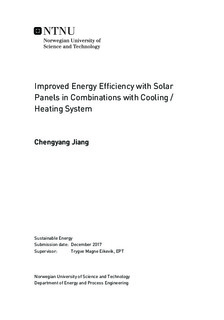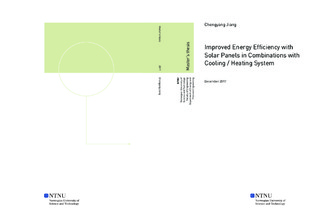| dc.description.abstract | Nowadays, with the unceasing human population growth and fast economic development, the global energy demand is also increasing unceasingly. Meanwhile, the increasing carbon dioxide emission has become a significant environmental problem. Building energy has now accounted for about 1/5 of the primary energy consumption all over the world. The number in China was 23.39% in 2009 and it is still growing fast. In particular, building sector has great potential of energy saving. With the development of renewable energy like solar energy and wind power, the energy structure in China can be more reasonable. What s more, part of the heating demand can be covered by heat pump whose efficiency is much higher than electric heating and gas heating.
The conversion efficiency of a photovoltaic (PV) cell is greatly influenced by its temperature. According to experimental results, every 1°C rise in cell temperature reduces the conversion efficiency by about 0.4% for multi-crystalline cells. Therefore, many researches have been done to decrease the PV panel temperature to increase the performance. Different types of PV/T collectors were developed to realize the comprehensive utilization of solar photovoltaic/thermal (PV/T) energy. The main difference of these collectors is working media which can be air, water, refrigerant and heat pipe.
When the air or the water was used as working media of PV/T collectors, it was usually heated to a high temperature for direct heating usage. This was actually on the opposite direction of conversion efficiency improvement. In this thesis, a PV panel was combined with a heat pump system. The refrigerant used in this work is propane (R290) and it is an environmental friendly working fluid whose ODP and GWP is 0 and 3. The evaporator of the heat pump was fixed under the PV panel. This combination, which is called PV evaporator in the following, can improve the conversion efficiency by cooling the PV cells and absorb solar thermal energy to produce hot water with the help of heat pump at the same time. What s more, the temperature of refrigerant is constant and relatively low during evaporation, this is good for the performance of PV cells.
Based on the concepts above, a test rig of PV/T heat pump system was designed and built. Experimental researches were taken under summer weather conditions of Trondheim. According to the experimental results, the conversion efficiency of the PV panel can reach 15.5% in the best case, it was increased by 6.9% compared with the nominal value. The efficiency was influenced by solar radiation, ambient temperature and angle of incidence. A higher ambient temperature leads to a lower efficiency. The influence of the solar irradiance is complicated, ordinarily, a higher solar radiation may cause a decline in efficiency. The PV evaporator can absorb heat both from solar radiation and environment, the heat-collecting efficiency ranged from 0.45 to 0.77 in the tests. The COP of the heat pump is greatly influenced by the condenser supply water temperature. COP decreases with the increasing condenser supply water temperature. Solar radiation and ambient temperature have a positive impact on COP. The average COP of the heat pump can reach 4.3 when the water was heated from 14.8°C to 50.6°C. The fractional errors of the measured conversion efficiency, COP are 5% and 5.2%.
Simulation of the test rig was made by EES to study the performance of PV/T heat pump system at different places and climates. The effectiveness of the simulation was validated by comparing the simulated results and experimental results. Daily performance analysis on April 30 in Shanghai was done, and it indicated that a higher air temperature leads to a better comprehensive performance. Annual operation simulated results in Shanghai, Oslo, New Delhi were analyzed. Monthly average value of air temperature, solar radiation and wind speed was adopted as the rated condition for annual performance evaluation. The annual average COP in Shanghai, Oslo, New Delhi are 3.5, 2.8 and 4.4, respectively. And the annual average conversion efficiency in Shanghai, Oslo, New Delhi are 16.4%, 17.3%, 15.5%. An air evaporator in parallel and an inverter compressor can be used to improve the performance in cold environment without sufficient sunlight. | |

